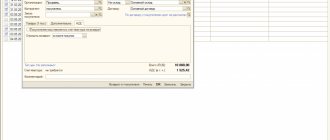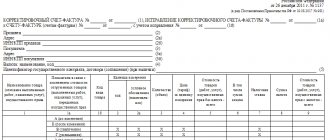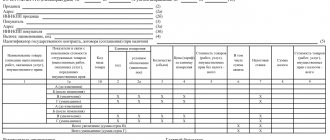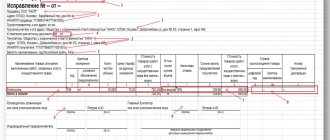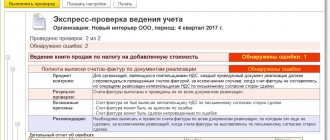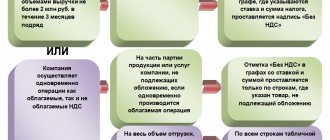The cost of goods has decreased: what documents are needed from the supplier?
The seller (supplier) can reduce the cost of goods after they have been shipped to the buyer.
When this can happen, says the material “What is an adjustment invoice and when is it needed?” .
At the time of making such a decision, the parties to the transaction already have the following set of documents in their hands:
- contract with initial delivery conditions;
- original invoice (PSF);
- primary document for the shipped goods;
- other documents (certificates, technical specifications, etc.).
A decrease in the cost of goods is accompanied by additional documents:
- agreement or other type of consent of the buyer to change the initial terms of the transaction (clause 10 of article 172 of the Tax Code of the Russian Federation);
- adjustment invoice (CSF) for reduction;
- a new primary document on changes in the value of goods containing the necessary details (Article 9 of the Law “On Accounting” dated December 6, 2011 No. 402) - it will serve as the basis for reflecting adjustment transactions in accounting (letter of the Federal Tax Service of Russia dated January 24, 2014 No. ED-4 -15/ [email protected] ).
The absence of these documents may deprive counterparties of the right to deduct VAT under the CSF and leave adjustment accounts unconfirmed.
You can view and download a sample adjustment invoice for reducing the price of goods in ConsultantPlus. Get trial access to the system for free and proceed to the filling example.
From the next section, find out what actions are required in the accounting of the buyer and seller when the CSF appears.
In what case is this document necessary?
An adjusting invoice (CAI) is a document to reduce or increase the amount and is written when there is a change in the prices of goods, rights to property or services purchased by the buyer. Such cases include direct changes in the price of services or goods sold, as well as clarification of their quantity.
Thus, a decrease or increase in cost can occur at the end of the month when using a system of regulated prices, and the total quantity of goods can be clarified if the buyer returns defective products. The use of such adjustment invoices is very convenient , as it relieves the seller of the obligation to make changes to the main invoice.
It is worth considering that it should be filled out no later than 5 days after receiving the contract from the buyer, confirming the latter’s consent to adjust the data (according to paragraph 10, paragraph 172 of the Tax Code of the Russian Federation).
We talked in detail about the cases in which such an adjustment document is required here, and you will find more information about the timing of issuing adjustment invoices in a special material.
Where are reduction adjustment invoices recorded?
The CSF for reduction is subject to registration by both the seller and the buyer.
Seller's actions
By reducing the cost of shipped goods, the seller:
- draws up a CSF or consolidated CSF;
- transfers data from the KSF (consolidated KSF) to the purchase book (clause 13 of Article 171 of the Tax Code of the Russian Federation);
- takes for deduction the difference between the VAT amount on the PSF and the reduced tax amount calculated after making adjustments.
The seller has the following rules regarding CSF for reduction:
- VAT clarification for the period when the shipment occurred does not need to be submitted;
- It is possible to claim a deduction within 3 years from the date the CSF is set for reduction (clause 10 of Article 172 of the Tax Code of the Russian Federation).
Buyer actions
The buyer upon receipt from the seller of CSF for reduction:
- registers it in the sales book;
- restores the portion of VAT previously accepted for deduction.
He will not have to submit an updated declaration and pay penalties.
Find out how to take into account and use what details to transfer VAT penalties from the article “Under which BCC are VAT penalties paid?”
Where and how to reflect
How to reflect an adjustment invoice for a reduction in price and/or quantity of goods (work, services) is generally stated in paragraph 13 of Article 171 and paragraph 10 of Article 172 of the Tax Code of the Russian Federation.
You can download this form from our website using the following link.
Here's how to post a reduction adjustment invoice issued by the seller. He needs to make an entry about this document in the purchase book. Grounds – clause 12 of Section II of Appendix No. 4 to the Decree of the Government of the Russian Federation of December 26, 2011 No. 1137
- make changes for the quarter of registration of the original invoice;
- submit an updated return for the given quarter to the tax authority.
- primary about reducing the cost of shipment;
- adjustment invoice (paragraph 2 of clause 14 of Section II of Appendix No. 5 to the Decree of the Government of the Russian Federation No. 1137).
The mentioned Decree of the Government of the Russian Federation dated December 26, 2011 No. 1137 determines where the adjustment invoice for the reduction is reflected. So, in column 15 of the purchase book, the seller provides the indicator from column 9 on the line “Total decrease (sum of lines D)” of the adjustment invoice.
In turn, an adjustment invoice for a decrease from the buyer requires the following actions from him. The sales book must reflect the earliest document in date:
Also see “Filling out the book of purchases and sales: cheat sheet from the Federal Tax Service.”
How not to lose a deduction on an adjustment invoice for a reduction?
The CSF for reduction is a document on the basis of which a taxpayer can claim a VAT deduction. You can use the right to deduction only if the CSF does not contain significant errors.
For example, controllers may refuse a deduction if in the CSF:
- goods not specified in the PSF are listed;
- negative values are indicated (all numbers in the CSF must be positive, even when adjusting the cost of the product downward).
When errors in invoices cannot deprive a deduction, find out from the material “What errors in filling out an invoice are not critical for deducting VAT?”
K+ experts explained in detail how to correct errors in an adjustment invoice. You can find out the procedure by getting free trial access to the system.
Learn about other errors inherent in the CSF that can negatively affect the deduction in the next section.
Correct filling
- The first step is to indicate the date the invoice was filled out and its serial number. Then the data of the main invoice is indicated, for which the corrective document is drawn up. Here you need to indicate its number, full details of the seller (including checkpoint and tax identification number) and full details of the buyer. All of this information must exactly match that on the master invoice.
- Next comes the main part in the form of a table, which names: the digital data of the original invoice, the new adjusted data, as well as the general difference between them. In this case, only information that has changed should be entered into the table. Goods and services whose prices have not changed do not need to be indicated.
- Also, if a quantitative change has occurred (for example, when a part of the goods is returned by the buyer), this data is also noted in the adjustment invoice.
If necessary, we described how to correctly issue an adjustment invoice here.
Consolidated adjustment invoice: can it be prepared when the cost of goods decreases?
The supplier may issue a single (consolidated) CSF if adjustments to the cost of goods are needed for several deliveries to one buyer.
This opportunity has been provided for the last 5 years thanks to clause 5.2 of Art. 169 of the Tax Code of the Russian Federation (after the entry into force of the law dated 04/05/2013 No. 39-FZ).
Registration of a consolidated CSF for reduction is possible if:
- the seller agreed with the buyer to reduce the cost of shipped goods;
- the decrease affects several (two or more) deliveries issued with separate primary invoices.
The unified CSF must contain information:
- about all serial numbers and dates of issued PSF;
- on the quantity of goods and their total cost (with and without VAT) for all invoices before and after adjustments;
- the difference between invoice values before and after changes are made.
In the consolidated CSF, errors are also possible that will not allow the taxpayer to claim a tax deduction. The main specific error of this document is the indication in it of data on several buyers (subclause 3, clause 5.2, article 169 of the Tax Code of the Russian Federation). It is also unacceptable in the consolidated CSF to collapse the totals if the cost of some goods decreases and others increases.
Design rules
Five days are allotted for the preparation and delivery of an adjustment invoice to the buyer from the date of the decision to make changes and its documentation. The CSF must be drawn up in two copies.
If prices or quantities change for several items of the primary document, then information for each item must be indicated separately.
The Tax Code allows you to issue one adjustment invoice for several shipping invoices issued to one buyer (clause 13, clause 5.2, article 169). In this case, information about identical goods (works, services), the shipment of which was documented in several documents at different times, can be indicated in total. This is possible if the shipment was made at the same price and the following has changed:
- delivery quantity;
- the price is the same amount compared to shipping.
Results
A decrease in the cost of goods after their shipment is accompanied by the issuance of an adjustment invoice, which the seller registers in the purchase book, and the buyer in the sales book.
Unified (consolidated) adjustment invoices are registered in the same way. At the same time, they can reflect adjustments for several deliveries to only one buyer - indicating several buyers in a consolidated adjustment invoice will be considered erroneous and may cause a refusal of a tax deduction.
Sources:
- Tax Code of the Russian Federation
- Federal Law of December 6, 2011 N 402-FZ “On Accounting”
You can find more complete information on the topic in ConsultantPlus. Free trial access to the system for 2 days.
Error when issuing a correction invoice for defects
Corrective invoices are drawn up by the supplier on the condition that a damaged part of the goods is discovered upon acceptance and if the defective goods are disposed of by the buyer (not returned).
If the buyer refuses to accept the defective shipment of goods, the seller does not issue an adjustment invoice. At the same time, the buyer does not issue an invoice for the return of defective goods. In this case, the goods are not capitalized, i.e. there is no reverse implementation. The seller reflects the VAT deduction based on the invoice issued by the same seller when shipping the defective goods.
Basic bu. records
When an adjustment invoice for a reduction is received from the seller, the posting will depend on the reasons for its formation:
- Receiving a discount on products already purchased. According to the terms of the contract, she changes the price. There are two possible situations here:
- Discount on products not yet sold by the client:
- STORNO D41 – K60 – purchase of products for the amount that is written in the fifth column of the line “total reduction” of the adjusted invoice;
- D60 – K68 – restoration of the VAT amount for the amount from the eighth column of the line “reduction in total”.
- Discount on products already sold by the client:
- STORNO D90-2 – K60 – the cost of sales is written off for the amount written in the fifth column of the line “reduction in total”;
- D60 – K68 – VAT has been restored for the amount reflected in the eighth column of the line “reduction in total”.
- A smaller number of products was accepted than reflected in the initial invoice - there is no need to change anything in accounting, since the products are received only upon acceptance.
Cases of generating an adjusted invoice
An adjusted invoice is generated if, after the product has been shipped:
- There has been a decrease in the number or volume of products compared to what is reflected in the standard invoice;
- The price of the product has decreased compared to that reflected in the initial invoice;
- There was both a price reduction and a decrease in the volume (quantity) of products;
- The client, who is not recognized as a VAT payer, returned part of the products to the seller.
